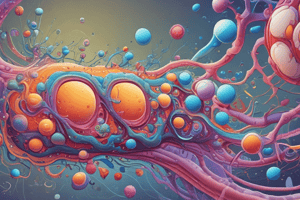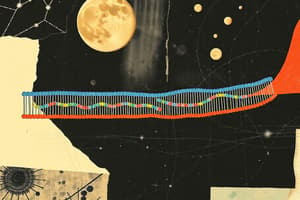Podcast
Questions and Answers
Which of the following best describes diffusion?
Which of the following best describes diffusion?
- Movement down a concentration gradient (correct)
- Movement from lower to higher concentration
- Movement of water only
- Movement against a concentration gradient
Osmosis is the movement of molecules from a concentrated solution to a dilute solution.
Osmosis is the movement of molecules from a concentrated solution to a dilute solution.
False (B)
What is the role of a partially permeable membrane?
What is the role of a partially permeable membrane?
To allow some molecules to pass while blocking others.
Active transport requires __________ to move molecules against a concentration gradient.
Active transport requires __________ to move molecules against a concentration gradient.
Match the following types of movement with their descriptions:
Match the following types of movement with their descriptions:
What happens to animal cells in a concentrated solution?
What happens to animal cells in a concentrated solution?
Plant cells can burst in dilute solutions due to the pressure of water uptake.
Plant cells can burst in dilute solutions due to the pressure of water uptake.
Name one example of where active transport occurs in the human body.
Name one example of where active transport occurs in the human body.
Flashcards
Diffusion
Diffusion
The movement of particles from a region of higher concentration to a region of lower concentration. This happens because particles are in constant random motion.
Osmosis
Osmosis
The movement of water molecules across a semi-permeable membrane from a region of high water concentration to a region of low water concentration.
Partially permeable membrane
Partially permeable membrane
A membrane that allows certain molecules to pass through while blocking others, usually based on size.
Active transport
Active transport
Signup and view all the flashcards
Solution
Solution
Signup and view all the flashcards
Solute
Solute
Signup and view all the flashcards
Solvent
Solvent
Signup and view all the flashcards
Aqueous solution
Aqueous solution
Signup and view all the flashcards
Study Notes
Introduction to Biology
- Biology covers various topics, including classification, cells, and movement across cell membranes.
Cell Membrane Movement
-
Passive Transport: Movement of molecules with the concentration gradient, no energy needed.
- Diffusion: Net movement of molecules from higher to lower concentration.
- Facilitated Diffusion: Diffusion aided by transport proteins.
- Osmosis: Diffusion of water across a selectively permeable membrane.
-
Active Transport: Movement of molecules against the concentration gradient, requiring energy (ATP).
- Used when cells need substances in small quantities.
-
Examples of active transport processes:
- Absorption of nutrients in the small intestine.
- Uptake of ions by root hairs in plants.
Types of Movement Across the Membrane
-
Active transport requires special pump proteins.
-
Passive Transport has three types: - diffusion - osmosis - facilitated diffusion
Osmosis
- Movement of water molecules from a dilute solution to a concentrated solution across a selectively permeable membrane.
- A solution with a higher solute concentration is called hypertonic; a solution with a lower solute concentration is called hypotonic; a solution with an equal solute concentration is called isotonic.
Consequences of Osmosis in Animal Cells
- In dilute solutions, animal cells take up water, swell, and may burst.
- In concentrated solutions, animal cells lose water and shrink.
Consequences of Osmosis in Plant Cells
- In dilute solutions, plant cells take up water, swell, and become turgid (firm). The cell wall prevents bursting.
- In concentrated solutions, plant cells lose water, the vacuole shrinks, and the cell membrane pulls away from the cell wall (plasmolysis). The cell becomes flaccid.
Diffusion in Animals
- Oxygen from the air enters the blood in the lungs.
- Carbon dioxide leaves the blood and enters the air in the lungs.
- Absorption of nutrients from the digestive system in the small intestine.
Diffusion in Plants
- Carbon dioxide from the air enters the leaves.
- Oxygen leaves the leaves.
Solution
- A solution is a liquid mixture of two or more substances.
- Solvent: The substance that dissolves other substances.
- Solute: The substance that dissolves in the solvent forming a solution.
- Aqueous solution: A solution where water is the solvent.
Studying That Suits You
Use AI to generate personalized quizzes and flashcards to suit your learning preferences.



